

Linux Device Drivers, 3rd Edition. Chapter 18. TTY Drivers. A tty device gets its name from the very old abbreviation of teletypewriter and was originally associated only with the physical or virtual terminal connection to a Unix machine.
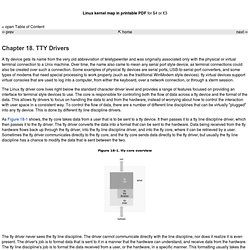
Over time, the name also came to mean any serial port style device, as terminal connections could also be created over such a connection. Some examples of physical tty devices are serial ports, USB-to-serial-port converters, and some types of modems that need special processing to work properly (such as the traditional WinModem style devices). tty virtual devices support virtual consoles that are used to log into a computer, from either the keyboard, over a network connection, or through a xterm session.
The Linux tty driver core lives right below the standard character driver level and provides a range of features focused on providing an interface for terminal style devices to use. 5.3.11. /proc/tty/ This directory contains information about the available and currently used tty devices on the system.
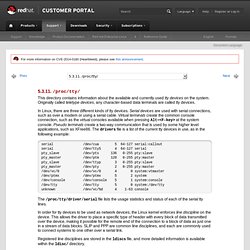
Originally called teletype devices, any character-based data terminals are called tty devices. In Linux, there are three different kinds of tty devices. Serial devices are used with serial connections, such as over a modem or using a serial cable. Virtual terminals create the common console connection, such as the virtual consoles available when pressing Alt+<F-key> at the system console. Pseudo terminals create a two-way communication that is used by some higher level applications, such as XFree86. Canonical Homepage. Greg Kroah Hartman on the Linux Kernel. Anatomy of the Linux kernel. History and architectural decomposition M.
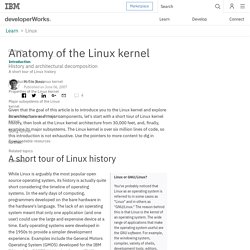
Tim JonesPublished on June 06, 2007 Given that the goal of this article is to introduce you to the Linux kernel and explore its architecture and major components, let's start with a short tour of Linux kernel history, then look at the Linux kernel architecture from 30,000 feet, and, finally, examine its major subsystems. The Linux kernel is over six million lines of code, so this introduction is not exhaustive.
Use the pointers to more content to dig in further. A short tour of Linux history Linux or GNU/Linux? You've probably noticed that Linux as an operating system is referred to in some cases as "Linux" and in others as "GNU/Linux. " While Linux is arguably the most popular open source operating system, its history is actually quite short considering the timeline of operating systems. Twenty years later, Andrew Tanenbaum created a microkernel version of UNIX®, called MINIX (for minimal UNIX), that ran on small personal computers. Sw. Table of Contents, Show Frames, No Frames A program is a set of computer instructions that perform a particular task.

That program can be written in assembler, a very low level computer language, or in a high level, machine independent language such as the C programming language. An operating system is a special program which allows the user to run applications such as spreadsheets and word processors. This chapter introduces basic programming principles and gives an overview of the aims and functions of an operating system. 2.1 Computer Languages 2.1.1 Assembly Languages The instructions that a CPU fetches from memory and executes are not at all understandable to human beings.
Ldr r16, (r15) ; Line 1 ldr r17, 4(r15) ; Line 2 beq r16,r17,100 ; Line 3 str r17, (r15) ; Line 4 100: ; Line 5 The first statement (on line 1) loads register 16 from the address held in register 15. 2.1.2 The C Programming Language and Compiler if (x ! Struct { int i ; char b ; } my_struct ; Conceptual Architecture of the Linux Kernel. Ivan Bowman January 1998 For Ric Holt CS746G Assignment One Available at:
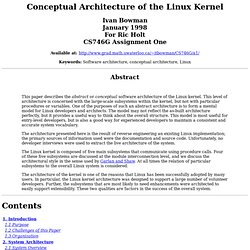
The Linux Kernel. The "Virtual File System" in Linux. Reprinted with permission of Linux Journal This article outlines the VFS idea and gives an overview of the how the Linux kernel accesses its file hierarchy.

The information herein refers to Linux 2.0.x (for any x) and 2.1.y (with y up to at least 18). The sample code, on the other hand, is for 2.0 only. The main data item in any Unix-like system is the ``file'', and an unique pathname identifies each file within a running system. Every file appears like any other file in the way is is accessed and modified: the same system calls and the same user commands apply to every file.
What is NFS. The Linux (Virtual) File System. Probably the most important difference (from the user’s perspective) between the DOS/Windows world and the Linux world is the organization and operation of the file system.

Some ideas will seem very familiar, and others will seem completely alien, but with a good understanding of the Linux file system, you have the skill to avoid some of the most common problems experienced by new Linux users. What is a file system? Ever go looking for a book in the library? In order to find what you’re looking for, you must understand the library’s file system, or method of organization.
Fiction books are easy, they use a simple type of file system commonly known as alphabetical by author. Online - Getting Started with Linux: Table of Contents.
The way of the program. Buy this book at Amazon.com The goal of this book is to teach you to think like a computer scientist.
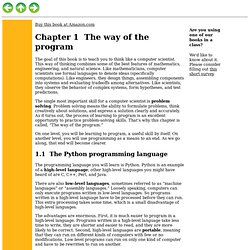
This way of thinking combines some of the best features of mathematics, engineering, and natural science. Like mathematicians, computer scientists use formal languages to denote ideas (specifically computations). Like engineers, they design things, assembling components into systems and evaluating tradeoffs among alternatives.